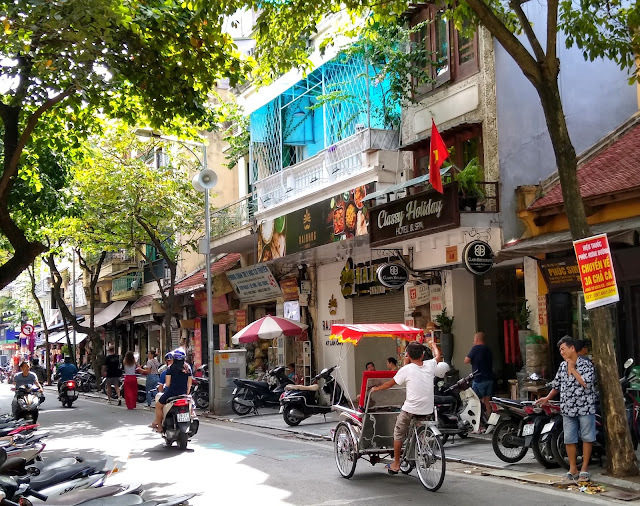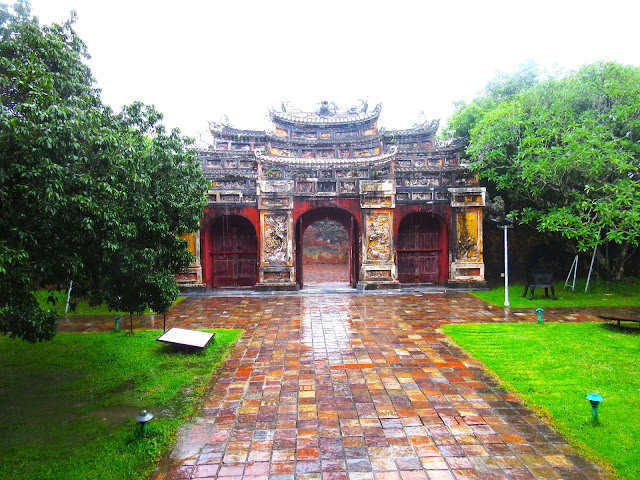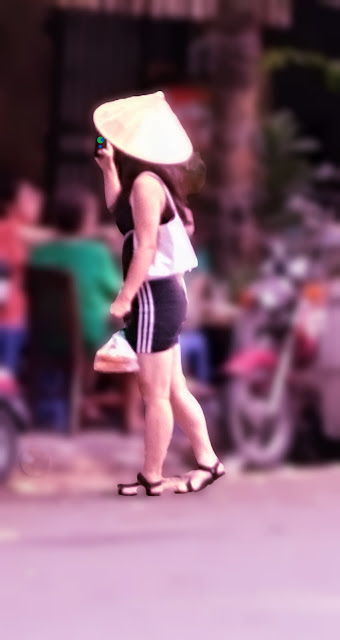 |
| Myra Rudin |
I cannot be sure why or when Vietnam was added to my bucket list. Until the U.S/Vietnam war became news in the 1960s I, probably like most teens (in the U.S.) could not locate it on a map or knew the difference between the Viet Cong and the Mekong. We knew little about the Chinese or French who tried to control and failed prior to the U.S. attempt.
Then, consumed daily with the horrors of the war in newspapers and on television, my generation began to take note. Along with flower children, long hair and beards, burning draft cards, flags, and bras, we marched in protest against what seemed like a no-win war against a country whose government was different from our own.
In 1975 it finally ended – with nothing gained and much lost. Along with the terrible scenes of war, perhaps the cone-shaped hats or the images of workers in rice paddies stayed with me. So, almost 50 years later, I at long last made my trip to Vietnam. With its growing economy, the country is in a stage of renewal and transformation into a more modernized society, while at the same time ensuring its old-world charm especially out of the big cities into the “back country” or suburbs.
As always, my photo preferences leaned towards the local scenes, people on the street, at work, in fields, or capturing someone in a temple or monastery. Of course, there was also the natural beauty of the countryside, and national parks with its flora and fauna. With a group, my trip began in Hanoi with stops in Hoa Binh (Mai Chau Valley), Ninh Binh, Hoi An, Ha Long Bay and Hue, ending in Ho Chi Minh City (Saigon).
HANOI
Hanoi, the capital, is best known for its Old Quarter (36 narrow streets of shops and stalls), the Temple of Literature (c. 1070), the Ho Chi Minh Mausoleum, and the Hoa Lo prison, known as the “Hanoi Hilton” during the war (where U.S. Senator John McCain spent 5 years). The relatively new Women’s Museum was excellent showing women’s contributions and their roles in Vietnamese history.
Bicycles and scooters transport everything from fruit to freezers and nothing beats the eye-popping chaos of motorbikes as a constant backdrop - trying to cross the road is an adventure in itself!
 |
| Daily life |
 |
| Types of homes |
 |
| Depiction at Hoa Lo Prison |
 |
| Photo Op |
 |
| Coffee on a bike |
 |
| Flower vendor |
 |
| Temple of Literature |
 |
| Catching up |
 |
A pyramid of fruits
|
 |
| Local transport |
 |
| Ready, Set, Go! |
HOA BINH and THANH HOA (MAI CHAU VALLEY)
Mai Chau, south of Hanoi, is a lush rural area with mountain vistas, rice paddies, farmland, and full of picturesque scenery. Nearby is Pu Luong nature reserve with footpaths for walking and hiking (grueling and sweating but...) .
 |
| Mai Chau landscape |
 |
| The valley |
 |
| Rural Hoa Binh |
 |
Hoa Binh
|
 |
| The rice paddies |
 |
| Worker at dusk |
NINH BINH (Province)
Cuc Phuong National Park is Vietnam’s first national park and largest nature reserve. What looks like snow on the mountains is actually limestone. Also in this area is the famous and interesting Thien Ha Cave, arriving by small canoes rowed by locals—a very peaceful (but rainy) ride. The cave was once used as a hideout in the 9th century and worshipped by locals later on as the “gateway to heaven”.
 |
| Ninh Binh house |
 |
| Transport to the cave |
 |
| Peaceful ride to the cave |
 |
| Local rower |
 |
| Thien Ha cave |
HA LONG BAY
Ha Long Bay is a Unesco World Heritage Site, noted for its many limestone cliffs of various sizes sitting in the waters of the bay. Under beautiful blue skies, some of us kayaked, while others took rowboats (me) to visit the Sung Sot Cave, the largest cave in the Bay, full of amazing forms and shapes. Accommodation in Halong was on a Vietnamese barge (modernized), each cabin with wonderful views of the Bay. I arose early to take photos of the sunrise, capturing one woman in her boat selling pearls (authenticity in doubt).
 |
| Scenic Ha Long Bay |
 |
| Starting the day |
 |
| Early morning calm |
 |
| Pearl seller |
 |
| The hilltop |
 |
| Into the cave |
HOI AN
We returned to Hanoi for a flight to Da Nang to arrive in Hoi An, about 18 miles away. Next to the Thu Bon river, the Hoi An central market is a trove of stalls and narrow streets selling all the veggies and other foods local to the area. Rain made for a very wet (soaked to the skin) visit but an interesting outing in any case. Hoi An was a trading port and now home to many old merchants’ houses, as well as the 400-year old Japanese bridge. Beautiful lanterns are everywhere – hanging in trees, storefronts, and restaurants. The wonderful old house Tan Ky (1741) is also a Unesco World Heritage site.
 |
| Hoi An color |
 |
| Daily life |
 |
| Busy prep |
 |
| Happy! |
 |
| Peaceeful street |
 |
| Flower seller |
 |
| Woman in a back room |
HUE
The drive from Hoi An to Hue is along the South China Sea. Hue was the ancient capital of Vietnam until 1945 and is home to the Imperial Citadel (another Unesco World Heritage Site) with its historic temples, shrines and gardens, and the iconic 7-story Thien Pu Pagoda (1601) which sits on a hill next to the Perfume River (normally “aromatic” but not during another rainy visit). Also here is the Austin car made famous in 1963 by a monk who drove it to Saigon and self-immolated in protest of the regime. (Well-known photos exist of that event.)
 |
| Hue proper |
HO CHI MINH CITY (Saigon)
Another flight from Hue was taken to reach Ho Chi Minh City (pop. 9 million+), now a combination of skyscrapers, designer shops, upscale cafés and international businesses, along with (thankfully) old French colonial architecture and other reminders of its turbulent past like the War Remnants Museum and the Cu Chi Tunnels. Both the Caravelle and Rex hotels still exist – home to journalists and military staff during the war. A cocktail on the roof terrace of the Caravelle provided some needed relaxation as well as great views of the city. In comparison, a boat ride through the Saigon River/ Mekong Delta was a highlight, revealing the many old stilt houses, some located in stark contrast to the modern hi-rises standing behind them.
 |
| Tai chi mornings |
 |
| Wonderful fruits & veggies |
 |
| All for sale |
 |
| Visit on a farm |
 |
| Buddhist temple |
 |
| Caravelle roof bar |
 |
| Contrasts in living |
 |
| Stilt homes |
LOOKING FORWARD
Emerging from a past of war, Vietnam is showing its resilience with a growing economy through international business, manufacturing, as well as tourism. One can see glimpses, especially with the younger generation, of optimism towards a more modern future (plenty of cell phones!) they seem to be aspiring to.
************************************************************************************
















































.JPG)







BRAVISSIMA Myra! Plaudits and Kudos to a wonderful travelogue on Viet Nam. Naturally I am biased having spent almost four years in the early 1980's serving in Hanoi. Like many others who have worked in the country I believe it has made the most durable imprint on my and Nadia's lives. Granted the period was unique, with the country just coming out of the long "American" war, going through the throes of re-unification between the north and south, having a brief but consequent conflict along its northern border with China, and entering into Kampuchea to defeat the Khmer Rouge and their murderous regime. Despite all these major military events, we were impressed with the resilience of the people, charmed by their humanity and humbled by the odds they faced in getting their lives back together. During my last visit in 2015 the words that struck me most were those of our colleague Trinh Thi Moui (retired) when I asked how she and her family were doing; she replied, "at last, we have PEACE !"
ReplyDeleteYour photos brought back wonderful memories of the old and the new Viet Nam, and you have captured so eloquently the essence of the people and the country-side. The photo "worker at dusk" is a master-piece of colour and context.
I am sure you have many more photos, and hope you will share them with XUNICEF in due course. Thank you.
Lovely pics!
ReplyDeleteI would vote this feature article of the year! It deserves wider circulation in a more complete travelogue. I collected Vietnamese art in the 90s (Phai, Tran Luc, Cu Ong etc) and am fascinated by the gracious culture that still exists.
ReplyDeleteThank you Peter, and others for your kind comments! Myra
DeleteI was 10 years old when the war of liberation broke out in Bangladesh. And 16 when the Vietnam war ended and 37 when I was lucky to go to Hanoi to work from New York HQs on transfer. I grew up at a time when war was thrusted upon us in Bangladesh and Vietnam. I knew the background of the war in Bangladesh, but not so much about the events that led to Vietnam war. I felt it would be unfair and unwise to go to work in Vietnam without knowing the proper history and its imperatives back then. After several books from Barnes and Noble and many hours of videos on VHS tapes, particularly Peter Annett’s “10 thousand day War”, I felt I was ready for Vietnam, albeit short of many things I would want to know without any source. Back in 1997, it wasn’t a time when metadata were organised by Google or YouTube to land your search on something that you wanted to know. Yet I learned who really were the leaders of Vietnam and what led to the war. But names of Ho Chi Minh, Le Duc Tho, Phan Van Khai, General Giap etc. became familiar from the books and videos on VHS tapes I could put my hands on. I left Vietnam in September 2000 after three years and witnessed first hand some of the first steps towards free market economies — most significant was Singtel’s entry in Vietnam for high speed Internet. During these three years I learned from many of my Vietnamese friends how a dismissive, powerful yet ignorant superpower failed, despite having all the intelligence to understand the simple aspirations of Vietnamese people and dragged a war to humiliating defeat. I have since returned to Vietnam many times, to witness its development and growth and many times I now come across Vietnamese tourists during my weekly street photography walks here in Penang where I live. There are daily direct flights from Penang to Ho Chi Minh city and I am going back to Vietnam for a full month in March 2024. This time starting from Ho Chi Minh City to Nha Trang, Da Nang, Hue, Hoi Ann, Hanoi, Ha Long Bay and Sapa. The Thang Long continues to grow in glory.
ReplyDeleteI hope Ken Burns would add another episode to his massive 18 hour long PBS Documentary “The Vietnam War” to show the results Vietnamese people achieved through blood and toil. Especially for we people who care and talk so much about “results”.
At these volatile times, Vietnam still remains a reminder that pompous perpetrators often become the victims of disgrace, for being blissfully ignorant about the future and blind about the past! Thanks for the lovely photos. I shall post a few of mine in April.